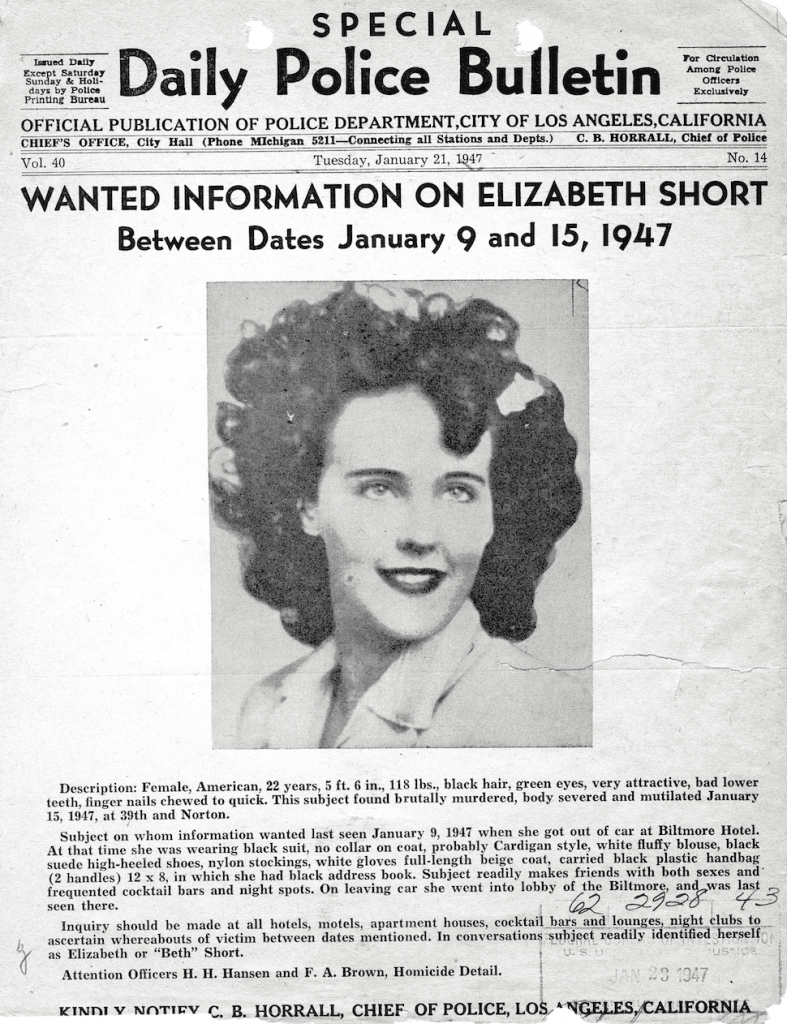Winner of the Fall 2019 StMU History Media Award for
Best Article in the Category of “Crime”
Elizabeth Short, widely known as The Black Dahlia, was a young 22-year-old American woman who was raped, brutally murdered, dismembered, and thrown on a vacant lot in a Los Angeles suburb for everyone to see. Elizabeth’s murder took place in Los Angeles County on January 15, 1947. No one knows the exact events that led to Elizabeth Short’s last moments when she fought for her life. There was no murder confession, and there was a lack of evidence to lead investigators further. Sadly, Elizabeth Short and her family never saw justice for her brutal murder. To this day, the case of The Black Dahlia is still unsolved. A man named Steve Hodel believed that The Black Dahlia murder was in fact not unsolved. Steve Hodel, a former detective, believed he had solved one of Los Angeles’ most notorious murders—but the infamous, troubled, charismatic doctor that Steve Hodel accused for being Short’s murderer, happened to be his own father, George Hodel.1
Elizabeth Short aspired to be an actress, and her young life was full of drinking and partying. She was very attracted to men and the sexual connections that came with men. Short had a desire to attend nightspots and nightclubs. Going to these nightspots, she frequently drew attention to herself, and she was arrested on September 23, 1943 for underage drinking of alcohol. She was only nineteen.2 By this time, Elizabeth had achieved a reputation as an aspiring actress who would go to bed with anyone who could possibly offer her a part in a movie.3 But her lifestyle soon led her to have a horrible encounter with a horrible man.

January 15, 1947 was just like any other day in the Los Angeles area. It was especially cool and overcast, which set the mood for the horrific discovery later that morning. A woman walking with her young daughter caught a glimpse of white flesh through a clump of brown grass in a vacant lot just a few inches from the sidewalk.4 They stumbled across the horrific sight of Elizabeth Short’s naked body cut in half just above the hipbone, drained of blood and arranged as if on display, with her legs spread and arms raised at right angles above her head. In a gruesome addition, two knife gashes extended her mouth up towards her ears.5 Her body also had the letters “B D” carved deeply into one thigh, and these letters were believed to represent the initials of Elizabeth Short’s well-known nickname Black Dahlia.6 This name stuck with her because of her tendency to always wear black clothing that contrasted with her white complexion, as well as having a dahlia flower in her hair on most occasions.7

George Hodel seemed to be an extraordinary man. He was a phenomenal doctor with a very respected reputation. Due to the extensive dismembering and perfect cuts discovered on Elizabeth’s body, her murderer had to have been a doctor.8 A couple years after the Black Dahlia murder, in 1949, Dr. Hodel’s reputation was left in tatters when he was tried for incest with his daughter Tamar Hodel, Steve Hodel’s half-sister.9 This trial brought light to George Hodel’s name in the police department. Because everyone knew that he was a very talented doctor, Dr. Hodel was put at the top of the suspect list for Elizabeth Short’s murder. Due to police corruption at the time, Dr. Hodel’s possible guilt was not presented to the public.
Dr. Hodel ended up passing away on May 16, 1999 due to a heart attack.10 Upon his passing, his son Steve Hodel began an intensive investigation into his father’s past. Steve Hodel made the trip to his father’s home to gather his father’s assets. While looking through his father’s belongings, Steve came across a tiny, palm-sized wood-bound photo album, with twelve golden fleurs-de-lys imprinted on the front.11 Inside this photo album, Steve discovered a number of strange photos of many familiar women. One of the women looked very similar to the Black Dahlia, Elizabeth Short. There were two photos of this women. In one, the woman had paper dahlia flowers in her hair. In the other, the woman was nude with her eyes shut.12 After Steve realized that the women in his father’s old photo album was the Black Dahlia, he became determined to find answers, to possibly clear his father’s name in the eyes of the law. Shortly into his private investigation, Steve Hodel realized that the evidence he was uncovering led to his father’s obvious guilt, not his exoneration. Now he wanted only to do all he could to prove it.
When Steve Hodel started the investigation into his father’s connection to the murder of the Black Dahlia, he found a substantial amount of sufficient yet circumstantial evidence against him. He soon found out that his father and Elizabeth Short knew each other. They had met in 1944 and had begun a non-sexual relationship. George would provide Elizabeth with financial aid for food and rent whenever she needed it in return for showing love interest in George. Steve’s suspicions of his father’s guilt skyrocketed when he came to find out that Elizabeth and his father were together at a downtown hotel three days before Elizabeth’s body was found. During the course of Steve Hodel’s investigation, he recognized his father’s unique handwriting multiple times, especially on the original note mailed by the Black Dahlia Avenger to the LAPD and to the press. The note with his father’s handwriting read “Here it is; Turning in Wed; Jan. 29 10 A.M.; Had my fun at police; Black Dahlia Avenger.” This was the first note that the Black Dahlia Avenger made no attempt to distort or conceal his actual handwriting.13 Hand writing analysis has since confirmed these claims. Although this evidence is circumstantial, Steve Hodel was very passionate in proving his father’s guilt. Another piece of incriminating evidence was a white-faced military watch that Dr. Hodel was seen wearing in contemporary photographs. A similar watch was found in the vacant lot close to where Elizabeth’s body was found.14
A number of men and one woman confessed to the crime, but none of them were able to match the gory details of the slaying known only by the police.15 Elizabeth’s murder seemed to bring out the worst among the psychologically disturbed in the Los Angeles area. The police were overwhelmed with the number of people who confessed to the murder.16 Despite all of these possible killers, Steve Hodel still truly believes that George Hodel was the guilty one.

The former detective for the LAPD and George Hodel’s son, Steve Hodel, had concluded his investigation on his father’s guilt, and developed an accurate timeline and detailed insight into Elizabeth Short’s last moments. Steve Hodel believes that the torture began on January 14, 1947 around 3:00-4:00 PM. Around this time, George Hodel took Elizabeth Short to the Franklin House. He gagged her mouth, bound her hands and feet with rope, and then began a prolonged and systematic process in which Elizabeth was beaten and subjected to ritualistic and sadistic torture.17 The torture included, but was not limited to the infliction of minor cuts to her body. She was beaten and kicked about her entire body, and she was forced to eat her own or his fecal excrement. Large pieces of flesh were cut from Elizabeth’s body and inserted into her orifices. Her face and breasts were also cut to imitate two of Man Ray’s famous photographs.18 Following this unimaginable torture, George Hodel then proceeded to sexually assault the then-slain Elizabeth Short.19 Although Elizabeth Short’s murderer was never convicted, it is now widely believed that George Hodel is the guilty one. The case of the Black Dahlia is considered an unsolved murder to this day, which makes it the most horrific unsolved murder in American history.20 Steve Hodel did not start his investigation until after George Hodel passed away, and only then because he passed away. George Hodel got away with his crime for over forty years. And even if he had not passed away until later in his life, face it, he still probably wouldn’t have ever been held to pay for his crime.
- Grace Bradberry, “My father was the Black Dahlia killer,” The Times, April 24, 2003. ↵
- Steve Hodel, Black Dahlia Avenger: A Genius for Murder (New York: Arcade Pub., 2003), 18. ↵
- Spectacular Crimes of the 1940s, 2007, s.v. “The Black Dahlia Case.” ↵
- Steve Hodel, Black Dahlia Avenger: A Genius for Murder (New York: Arcade Pub., 2003), 10. ↵
- Grace Bradberry, “My father was the Black Dahlia killer,” The Times, April 24, 2003. ↵
- Women in World History: A Biographical Encyclopedia, 2002, s.v. “Short,Elizabeth(1925–1947),” by Anne Commire. ↵
- Women in World History: A Biographical Encyclopedia, 2002, s.v. “Short,Elizabeth(1925–1947),” by Anne Commire. ↵
- Grace Bradberry, “My father was the Black Dahlia killer,” The Times, April 24, 2003. ↵
- Grace Bradberry, “My father was the Black Dahlia killer,” The Times, April 24, 2003. ↵
- Steve Hodel, Black Dahlia Avenger: A Genius for Murder (New York: Arcade Pub., 2003), 22. ↵
- Steve Hodel, Black Dahlia Avenger: A Genius for Murder (New York: Arcade Pub., 2003), 36. ↵
- Grace Bradberry, “My father was the Black Dahlia killer,” The Times, April 24, 2003. ↵
- Steve Hodel, Black Dahlia Avenger: A Genius for Murder (New York: Arcade Pub., 2003), 273. ↵
- Steve Hodel, Black Dahlia Avenger: A Genius for Murder (New York: Arcade Pub., 2003), 445. ↵
- Women in World History: A Biographical Encyclopedia, 2002, s.v. “Short, Elizabeth (1925–1947),” by Anne Commire. ↵
- Spectacular Crimes of the 1940s, 2007, s.v. “The Black Dahlia Case.” ↵
- Steve Hodel, Black Dahlia Avenger: A Genius for Murder (New York: Arcade Pub., 2003), 434. ↵
- Steve Hodel, Black Dahlia Avenger: A Genius for Murder (New York: Arcade Pub., 2003), 445. ↵
- Steve Hodel, Black Dahlia Avenger: A Genius for Murder (New York: Arcade Pub., 2003), 434. ↵
- Women in World History: A Biographical Encyclopedia, 2002, s.v. “Short, Elizabeth(1925–1947),” by Anne Commire. ↵



115 comments
Vianka Medina
The murder of the Elizabeth Short, the Black Dahlia, is my favorite unsolved case to look into. But I never knew the gruesome details of pure torture she went through, it would seem that it all lines up to Dr.George Hodel. This article did a tremendous job on giving a background story of both George Hodel and Steve Hodel. The idea of your father most likely being the murder of the most famous unsolved murder in America is unimaginable. I throughly enjoyed reading this, I can see why it deserved an award!
Alicia Martinez
The case of the Black Dahlia is quite unforgettable. I have heard and read on the case on multiple occasions, but I have never read an article as well put together as this. The page break of the articles sections allowed for an easy and interesting read. The transitions from the topic details were not forced and cohesive. Additionally, the article also provided information that I had never known about. I had always learned that this case remained unsolved with no real leads, along with only minimal details of her death. I really enjoyed reading this intriguing article.
Alexis Lopez
This article was really fascinating read. I never heard about this case before it is now something that I will look into. Saira Locke gave great information and also put all the different pieces together really well. I thought it was interesting that the son of the murderer was the one looking into his dad George Hodel. I also thought that it was crazy how nobody decided to question George because of how close he was to Elizabeth and the fact that everything done to her was perfectly cut it seems like George Hodel would be the person that killed Elizabeth. This article kept me entertained and interested the whole time.
Abilene Solano
The murder of the Black Dahlia never ceases to give me the creeps, I can’t imagine the pain and suffering Elizabeth Short went through. This article gave me more insight about the whole Black Dahlia case that I previously didn’t know before. For example, I didn’t know about Steve Hodel and his mission to show that his father is the actual murderer of the Black Dahlia. Honestly it surprises me that he continued to push forward with his investigation after finding out that his dad was guilty for the murder, I would assume that children would just drop their investigations after realizing that they were in too deep. Yet, I feel glad that Steve Hodel kept investigating in this case trying to put an end to the unsolved mystery of the brutal murder of the Black Dahlia. It’s scary to believe that this case is still unsolved even after years of it happening!
Justine Ruiz
A few years ago, I heard about the Black Dahlia case but never looked into it. It’s heartbreaking to read about her gruesome murder. This young woman went through so much torture for no absolute reason. She was just an aspiring actress who was infatuated with her future. I praise Steve Hodel for starting his private investigation on his own father. Not many children would want to investigate their parents knowing they were guilty. I found it interesting that Elizabeth and George Hodel had known each other for a while prior to her murder. He seemed like a good friend and person to her, how was she supposed to suspect that he’d murder her? All the evidence Steve provided showed that George was fully capable and did in fact murder Elizabeth Short.
Adrianna Hernandez
I had never heard about this case, but it was an amazing article to read. I’m very surprised that this is considered an unsolved murder. It frightens me how someone was able to help a person and then have the possibility of being the murder of that person. It also brings a good view as to what someone who is underage drinking could go through without being aware of the life risk they take upon themselves.
Reba Reyes
This is a very mysterious murder, nothing ordinary. It’s horrifying that this poor women was put through such traumatic torture. Elizabeth Short was oblivious to the fact that she really had no idea what was going to happen in her near future. Being a doctor who knows how to get away with murder and taking advantage of it defeats the entire purpose of this job. This leads to question other doctors who do this, what if they are behind an unsolved murder? It has happened before, so why would it not happen again?
Alyssa Ramos
I have never heard about this case before, but it is very interesting. It’s heartbreaking to know that torture and rape are common in this world, when they shouldn’t be. The amount of torture this poor girl went through, and no justice was served for her. Without Steve Hodel starting his own investigation, we would have never had this much evidence towards a killer. I like all the detail in this article from Elizabeth’s daily life to the gruesome details of her murder. It helps put the story together. This is definitely one of the top brutal murders I have read about.
Julianna Olivarez
I have read about the Black Dahlia prior to reading this article and I’ve learned more from this article than what I had read. I do believe that George Hodel was the murderer of Elizabeth because there’s to much circumstantial evidence against him that his own son has found from finding out that Elizabeth and George knew each other and he was with her three days before, his knowledge of anatomy and even his unique handwriting that matched the letter. Elizabeth death was one of the most gruesome murders I’ve ever heard of and she didn’t deserve to be tortured and bound the way she was. This was a great article.
Samson Pullattu
I am surprised that this case is considered unsolved with the mountain of evidence stacked up against Dr. George Hodel, as circumstantial as it may be. For someone to have helped people to better themselves for a living but to be willing to brutally torture someone is extremely concerning and only shows that a reasonably broad wariness of everyone is healthy. The force feeding of excrement is just sick-he’s a doctor, he should know that’s unhealthy.